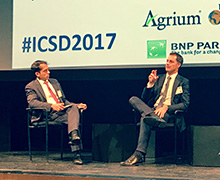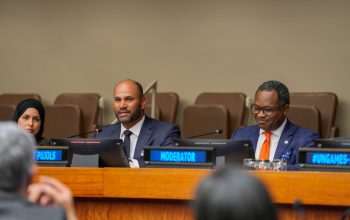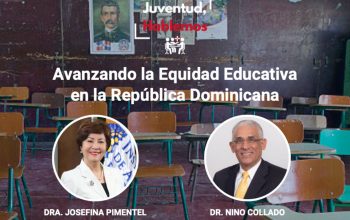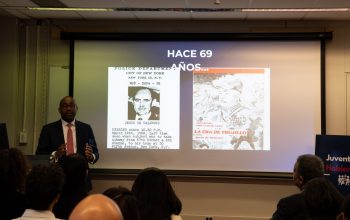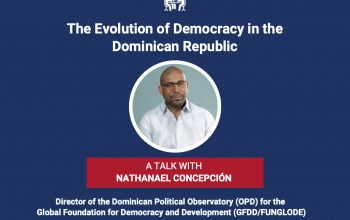news
“Acid Rain Disappeared because Citizens Demanded Action, Businesses Delivered Technical Solutions to and Political Leaders Made the Vision Happen” States Eric Solheim, UN Environment Executive Director at International Conference on Sustainable Development
September 26, 2017
GFDD attended the fifth edition of the International Conference on Sustainable Development (ICSD) at Columbia University in New York City on September 18-21, 2017. The theme of this year’s ICSD, hosted by the Sustainable Development Solutions Network (SDSN) and the Earth Institute’s Global Master’s in Development Practice (MDP) program was The World in 2050: Looking Ahead for Sustainable Development.
“This
year’s International Conference on Sustainable Development will be the most important and historic yet,” said SDSN Director and Columbia University Professor Jeffrey Sachs. “Not only will the science and policy be at the cutting edge, but ICSD will host students from around the world, top scientists, and world leaders from politics to government to the UN.”
The
ICSD brings together governments, academia, the United Nations and other international agencies, and NGOs and grassroots organizers to share practical solutions for the SDGs.
ICSD’s purpose is to identify and share practical, evidence-based solutions that can support the Sustainable Development Goals (SDGs).
Representing the foundation throughout the conference, Marc Jourdan, GFDD’s UN Programs & Outreach Manager, attended
the dialogues and parallel sessions which focused on a wide range of topics from the role of innovation in technology for socially inclusive economic growth to the science policy implementation interface for low carbon-urban development, with presentations from post-graduate scholars and policy experts from the United Nations and across the globe.
Over 1,000 attendees, crowded into the main auditorium on the first day to hear interventions from a variety of High-level
speakers including UN Environment Executive Director, Eric Solheim.
Mr. Solheim reminded attendees that “Pollution is now the biggest killer of humans”, calling on everyone to get engaged in the new Sustainable Development Goals. Reminding everyone that multi-stakeholder participation had worked in the past he stated that acid rain disappeared in the 70s because citizens demanded action, businesses delivered technical solutions and political leaders
made the vision happen”.
"What starts with academia needs to be taken up by politics and carried by all global actors." Added Jeff Sachs, Director of Columbia University’s Earth Institute, commenting on the SDG transformation Representing the private sector, Hervé Duteil of BNP Paribas stressed thed "Banks need to be in the business of bridging money to the investors to enable SDG projects to get off the
ground".
Finally, turning to the future generations, Chandrika Bahadur, the President of the SDSN Association, reminded the youth representatives at the conference that "It is young people who will be at the cutting edge of solving problems."
CSD
The aim of ICSD is to identify and share practical, evidence-based solutions that can support the Sustainable Development Goals (SDGs). This
year’s conference theme was Moving Forward: The SDGs in Practice. The ICSD provides a unique opportunity to bring together stakeholders from government, academia, the United Nations, international agencies, NGOs, and grassroots organizers to share practical solutions towards the achievement of more sustainable and inclusive societies.
About the UN Sustainable Development Solutions Network
UN Secretary-General Ban Ki-moon launched
the UN Sustainable Development Solutions Network (SDSN) to mobilize global scientific and technological expertise and to promote practical problem solving for sustainable development, including the design and implementation of the Sustainable Development Goals (SDGs). Following their adoption, the SDSN is now committed to supporting the implementation of the SDGs at local, national, and global scales. The SDSN aims to accelerate joint learning and help to overcome the compartmentalization
of technical and policy work by promoting integrated approaches to the interconnected economic, social, and environmental challenges confronting the world. The SDSN works closely with United Nations agencies, multilateral financing institutions, the private sector, and civil society. The organization and governance of the SDSN aims to enable a large number of leaders from all regions and diverse backgrounds to participate in the development of the network, while at the same time ensuring
effective structures for decision-making and accountability.
About the MDP Program at Columbia University’s Earth Institute
The Global Master’s in Development Practice (MDP), an interdisciplinary graduate degree program, prepares students to better identify and address the challenges of sustainable development. MDP programs generally consist of two years of coursework in four intersecting disciplines—health, natural,
social, and management sciences–combined with cross-sectoral field training. MDP programs belong to a global network of universities and collaborating organizations and have been developed according to recommendations outlined in the report of the International Commission on Education for Sustainable Development Practice.

